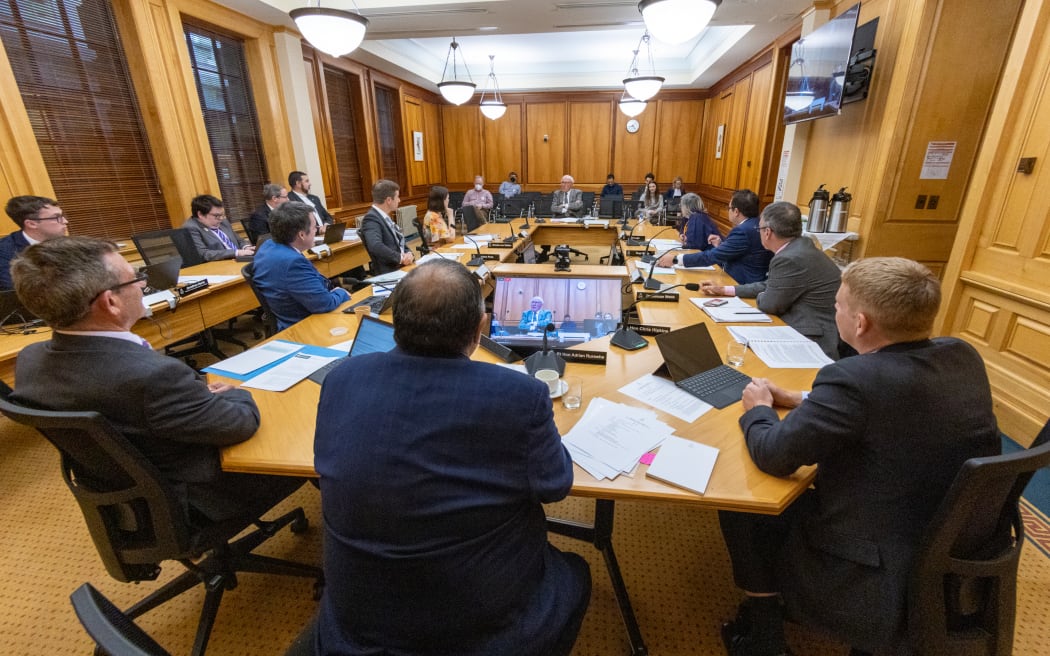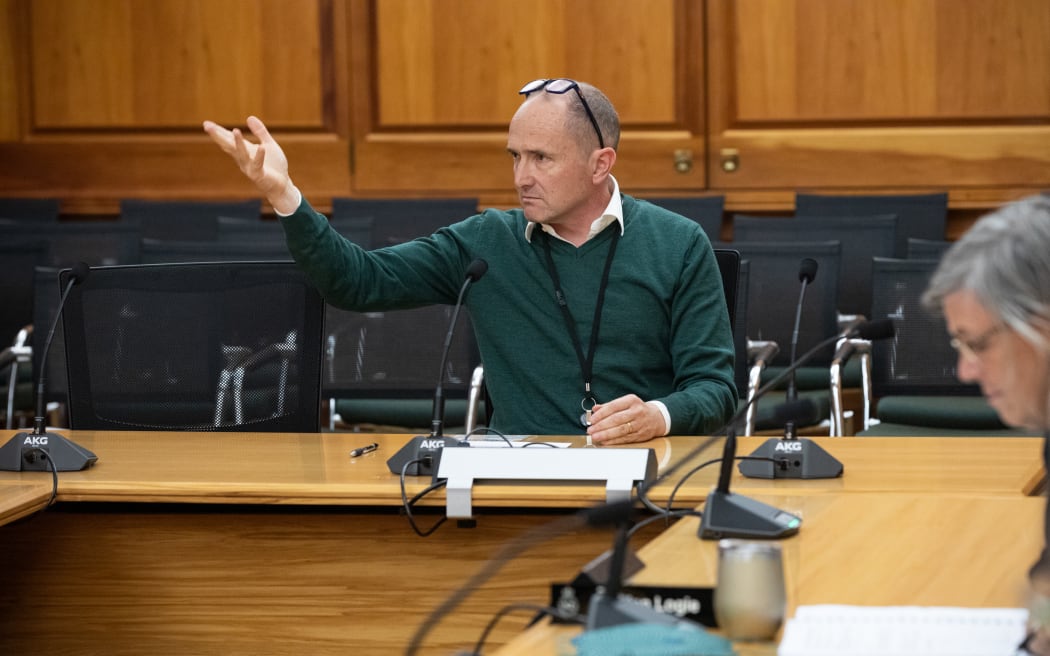Note: Since this article was published Parliament has extended the deadline for submissons to the Standing Orders Review until February 5th. This is specifically for submissions “on the House’s rules and principles relating to proposals for entrenchment”. This follows the kerfuffle over the Green Party amendment to entrench an aspect of recent Three Waters legislation.
…And now for the advertised programme:

Parliament's Standing Orders Committee hears evidence from a submitter, the former Prime Minister Sir Geoffrey Palmer for the 2023 Review of Standing Orders. Photo: VNP / Phil Smith
Parliament is reviewing its rules, as it does before every election, and has asked the public for advice.
They call giving advice ‘submitting’ – thankfully, it doesn't involve bowing or begging.
When our Parliament show The House first discussed this rules review, I said I would make a submission myself; partly for the experience of it, and partly so I could share what I learned.
The Standing Orders Committee run this review, looking for improvements in how the MPs pass laws, run select committees, and scrutinise government.
It is a weird and wonderful aspect of New Zealand’s Parliament that select committees regularly ask the rest of us if we have any helpful ideas on pretty much everything. Not every country does this.
As principal clerk Gabor Hellyer (who is administering the rules review) says: “It is ultimately the people's house. It’s the house-of-representatives-of-the-people, and so it's important that the public has an opportunity to have a say on how Parliament works".
I made a submission and will describe the experience. (Spoiler: I loved it – can I go again?)
More usefully, this article has tips on how to make a written or oral submission, and how not to. But first, why submit at all?
What are submissions for anyway?
Parliament’s select committees (small groups of MPs that focus on a subject area like Health or Finance) hear submissions on a range of things: on petitions, on proposed laws (called bills), and on inquiries they can decide to hold.
Submissions for each of those purposes vary, but have the basics in common. Most submissions (by far) are on bills – the laws being improved and approved by Parliament.
So let’s focus on submissions on bills.
It’s worth remembering that most bills that reach a select committee (especially government bills) are going to become law. Committees don’t decide whether to kill a bill, but whether to amend it.

Drowning MPs in thousands of identical submissions doesn't really achieve anything beyond offering some dodgy stats to a political speech. Photo: VNP / Phil Smith
Killing is not an option
The job of a good MP in committee (regardless of their party) is to make it the best law it can be – whether they support it or not.
When committees ask for submissions on a bill, that is what they are wanting help with – to improve it.
That means writing a submission to say “this bill is evil” is pretty pointless. It isn’t going to stop it and offers nothing else.
Even worse is sending a boiler-plate submission – the ones organised by pressure groups, churches, etc, where thousands of identical submissions turn up. They offer nothing beyond a dodgy statistic for a political speech.
The people that organise and send those are confusing submissions with petitions. Submissions are not a poll.
The types of feedback
What committees are looking for is problems, mistakes, ideas and suggestions. Also, crucially, they want real world experience of the area being affected.
Quite often people turn up to a committee and tell MPs how some apparently innocuous element of a planned law will have an unforeseen impact they haven’t thought of. You can see the MPs thinking “Well, bugger, we hadn’t thought of that”.
Those kinds of submissions are incredibly valuable. They avoid the unintended consequences, and they avoid MPs having to come back later and restart the whole process to amend the legislation.
Also crucially useful is the experience of people who have lived the issue. This kind of submission is the most potent thing that happens in a committee. It is also likely in submissions that relate to a petition or an inquiry.
This is where citizens eyeball MPs and relate their experience. Poverty, poor housing, dealing with pain, terminal suffering, bureaucracy … They can cover the whole “sea of troubles” including probably, “the proud man's contumely, the law's delay”, and “the insolence of office”.
These are quite possibly the most valuable submissions anyone makes and have the most effect. They have led directly to a number of recent law changes including self-determination of official gender, and the ban on so-called conversion therapy.
Submissions are powerful things and well worth the effort.

Clerk of the House of Representatives, David Wilson shows how it's done. Compare his calm with my own manic gesticulating (see below). Photo: VNP / Phil Smith
How to write a Submission
I asked David Wilson for guidance on writing effective submissions. As clerk of the House of Representatives he runs all of Parliament’s secretariat, and has written a fair few himself.
His advice boils down to this:
- “Upfront, identify what the issue is that you want to talk about and why”
- It doesn’t have to be about a problem, it could be an opportunity, an improvement or something new
- “Get to the point of it quite quickly” (MPs are already drowning in paper, don’t make it hard for them)
- Make your suggestion first. “If you're gonna provide evidence to support it do that afterwards”
- Be clear and concise. “A long submission isn't necessarily a good one”
As promised I prepared and submitted a written submission via Parliament’s website. It was surprisingly easy – it’s almost like they encourage it.
I followed David Wilson’s advice and kept it brief and to the point – a single page.
I also kept it narrow, focussing on modernising Parliament’s formal ‘process’ language.
Unlike one or two submitters to the Standing Orders Committee I did not propose a complete and detailed overhaul of New Zealand’s entire democratic structure (which wasn’t within the scope). Or indeed, as one did, offer myself as Prime Minister (god forbid).
My submission was narrow because I didn’t want to bite off more than I could chew. But I also think that specific, discreet suggestions are easier to argue and to grasp, and so more useful. Of course, you can make many of them within a submission.
The research bit
Note: Being specific will likely mean doing some research, but bills and explanations of them are available via Parliament’s website, so it’s both worthwhile and possible.
There is a page on the Parliament website for every bill, and it always has a link to the actual bill on the official legislation website (click on the green box that says – not very cryptically – “read the bill”).
Usefully on that site every bill also comes with an explanation (listed in the bill’s contents as “Explanatory Note”). Begin your research there.

The House journalist Phil Smith makes a submission to the Standing Orders Committee (or is he declaiming some Shakespeare? "I am determined to prove a villain, and hate the idle pleasures of these days....") Photo: VNP / Johnny Blades
Fronting up to a committee
When you make a written submission you are asked to indicate whether you want to turn up in person and speak to the committee. I said ‘yes’ and the committee clerks got in touch to arrange that. It was all surprisingly easy.
It isn’t compulsory to speak to a submission, or to be there physically. You can also submit via video.
I didn’t go in ‘cold’, I watched the submissions before my own to get a sense of the discussion. This might also settle your nerves.
This can also help you tie your own comments into the wider discussion. You are part of a conversation of sorts, so be aware of what has already been said in it. Increasingly you will be able to read the other written submissions online before you contribute which serves the same purpose.
At the appointed time I turned up to one of Parliament’s committee rooms and sat in a chair at the flat end of the horseshoe-shaped tables that select committees use.
(There are multiple chairs – you can submit as a group).
I can confirm that it is a bit intimidating – it’s a bit like a job interview with seven or more interviewers. But the MPs are actually inviting. (Job interviews are always terrifying.)
Leave your reading glasses at home!
The crucial advice for appearing in person is: Do not read out your submission to the MPs.
This is a mistake that almost every submitter I’ve ever seen has made. Honestly it's a waste of everyone’s time.
The MPs already have your written submission. They’ve had it for weeks. If they’re doing their jobs they’ve already read it. If they haven’t read it, then you boring them half to death by painstakingly ploughing through it isn’t going to help.
Instead, speak to it. They have your suggestions, so focus on your argument, not the details.
Preferably do not write that intro speech (unless it is very short and strong). Don’t read anything if you can help it. Just talk. And talk as briefly as possible. Leave time to discuss.

It's often a good sign if the MPs get animated. Here National MP Michael Woodhouse get energised in discussion with Sir Geoffrey Palmer in the Standing Orders Committee. Photo: VNP / Phil Smith
It's all about the conversation
It’s likely you will have only a five or 10 minute slot. That is not long. Be as brief and punchy as possible.
What you are trying to do is spark a discussion. You want questions. You want comments. They say about job interviews that the less you talk and the more the interviewers talk, the more they get engaged in the conversation; the more likely you are to get the job.
Select committees are similar. You are seeking engagement. You want your submission to lead to a wider discussion of possible approaches to deal with the issue you have raised.
Your job is to spur them into action with an outsider’s take.
Come to debate
Also, come, having considered possible counter-arguments. Be prepared to defend your point of view. Be prepared to debate, to argue (not in an angry way though – that doesn’t serve your cause).
Most MPs are intelligent, confident people and relish a little intellectual tussle.
They will likely raise objections even if they agree. They are right to want to ‘test’ the logic of your case and look for its flaws, its limits, alternatives. Do not be insulted – this is a good thing.
Don’t be put off or cowed by some push-back. This is exactly what you are wanting. It means they are genuinely thinking about what you have said.
You might even enjoy it. I did.
How it went – a recommendation
I can’t claim I was particularly good, I neglected to even glance at my notes (which can be good or bad). But I also didn’t read my submission, so that’s a definite win.
My colleague at The House, Johnny Blades, took a few photos of the event in which I appear to be trying to direct traffic or perform in a pantomime. (See above). Apparently that’s normal for me.
Regardless of the inevitably bruised ego, I hugely enjoyed the experience.
I recommend it. I would definitely do it again. In fact I wanted to immediately offer a half dozen supplementary submissions and climb right back in and discuss them all as well.


